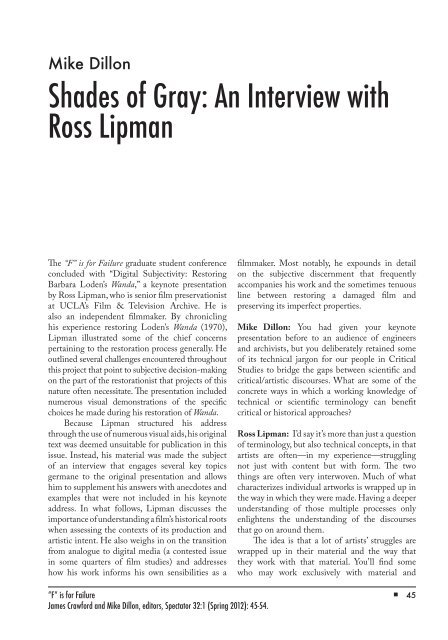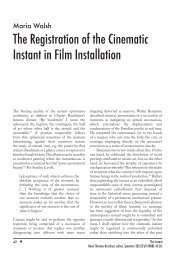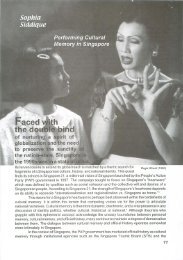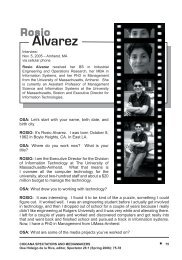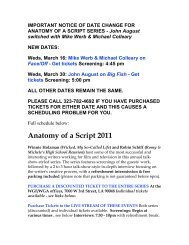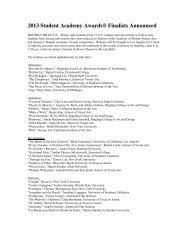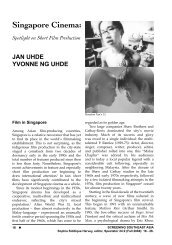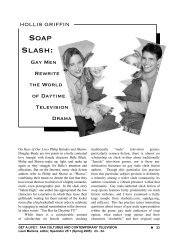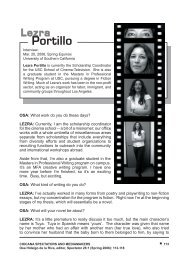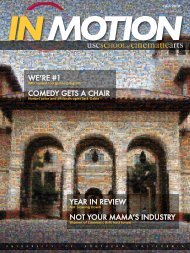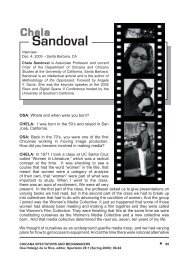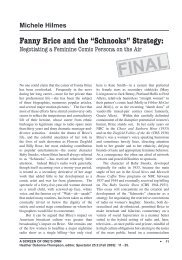7_Dillon.pdf
7_Dillon.pdf
7_Dillon.pdf
Create successful ePaper yourself
Turn your PDF publications into a flip-book with our unique Google optimized e-Paper software.
Mike <strong>Dillon</strong><br />
Shades of Gray: An Interview with<br />
Ross Lipman<br />
The “F” is for Failure graduate student conference<br />
concluded with “Digital Subjectivity: Restoring<br />
Barbara Loden’s Wanda,” a keynote presentation<br />
by Ross Lipman, who is senior film preservationist<br />
at UCLA’s Film & Television Archive. He is<br />
also an independent filmmaker. By chronicling<br />
his experience restoring Loden’s Wanda (1970),<br />
Lipman illustrated some of the chief concerns<br />
pertaining to the restoration process generally. He<br />
outlined several challenges encountered throughout<br />
this project that point to subjective decision-making<br />
on the part of the restorationist that projects of this<br />
nature often necessitate. The presentation included<br />
numerous visual demonstrations of the specific<br />
choices he made during his restoration of Wanda.<br />
Because Lipman structured his address<br />
through the use of numerous visual aids, his original<br />
text was deemed unsuitable for publication in this<br />
issue. Instead, his material was made the subject<br />
of an interview that engages several key topics<br />
germane to the original presentation and allows<br />
him to supplement his answers with anecdotes and<br />
examples that were not included in his keynote<br />
address. In what follows, Lipman discusses the<br />
importance of understanding a film’s historical roots<br />
when assessing the contexts of its production and<br />
artistic intent. He also weighs in on the transition<br />
from analogue to digital media (a contested issue<br />
in some quarters of film studies) and addresses<br />
how his work informs his own sensibilities as a<br />
filmmaker. Most notably, he expounds in detail<br />
on the subjective discernment that frequently<br />
accompanies his work and the sometimes tenuous<br />
line between restoring a damaged film and<br />
preserving its imperfect properties.<br />
Mike <strong>Dillon</strong>: You had given your keynote<br />
presentation before to an audience of engineers<br />
and archivists, but you deliberately retained some<br />
of its technical jargon for our people in Critical<br />
Studies to bridge the gaps between scientific and<br />
critical/artistic discourses. What are some of the<br />
concrete ways in which a working knowledge of<br />
technical or scientific terminology can benefit<br />
critical or historical approaches?<br />
Ross Lipman: I’d say it’s more than just a question<br />
of terminology, but also technical concepts, in that<br />
artists are often—in my experience—struggling<br />
not just with content but with form. The two<br />
things are often very interwoven. Much of what<br />
characterizes individual artworks is wrapped up in<br />
the way in which they were made. Having a deeper<br />
understanding of those multiple processes only<br />
enlightens the understanding of the discourses<br />
that go on around them.<br />
The idea is that a lot of artists’ struggles are<br />
wrapped up in their material and the way that<br />
they work with that material. You’ll find some<br />
who may work exclusively with material and<br />
“F” is for Failure<br />
James Crawford and Mike <strong>Dillon</strong>, editors, Spectator 32:1 (Spring 2012): 45-54.<br />
45
SHADES OF GRAY<br />
others who work more in the realm of content.<br />
But there usually is some kind of dialogue going<br />
on between content and material, and sometimes<br />
misunderstandings arise when the community<br />
that is receiving the work does not have a deeper<br />
understanding of the production context. That<br />
becomes even more challenging with older works<br />
as time passes. When works are current, there’s<br />
generally an assumption that most people who<br />
will be perceiving or receiving them have at least a<br />
general familiarity with the environment in which<br />
the works are made and maybe even some of the<br />
processes by which they are made. But that recedes<br />
with time.<br />
My favorite example of this is The Exiles<br />
(1961), by Kent Mackenzie—a good USC boy,<br />
of course—who made that film out on location.<br />
One of the things The Exiles is renowned for is<br />
the amazing location cinematography by Erik<br />
Daarstad, John Morrill, and Robert Kaufman.<br />
And while the cinematography is remarkable,<br />
one thing that’s fluctuating a bit throughout the<br />
film is the sound. Although they did record sound<br />
on location, they only were able to use those<br />
recordings as guide tracks. The quality was often<br />
poor, and they redubbed the dialogue in the studio,<br />
so that what you’re hearing is not location sound;<br />
it’s ADR, added later. Some people look at that as<br />
a flaw. There are voices from some quarters saying,<br />
“If not for the poor quality of the dubbed dialogue,<br />
this would be a better film.” What does not enter<br />
into the discourse that I’ve seen is a discussion<br />
of the historical context in which The Exiles was<br />
produced. And what’s key to understanding this<br />
is the time it was being shot, between 1957-1959.<br />
That’s really at a moment just preceding cinéma<br />
vérité. The Nagra III sound recorder was just<br />
then being developed. There were certainly Nagra<br />
models out, but the technology had not been<br />
perfected yet. It was only in the early 1960s, a little<br />
later, that you really began getting that portable,<br />
high-quality sound equipment functional. Part<br />
of what Mackenzie was doing was anticipating<br />
cinéma vérité before it happens, but without the<br />
technology that would enable it. When you get<br />
into it and you look at what he actually did do with<br />
the sound, there are some really innovative things<br />
that he achieved, and some work brilliantly, while<br />
others are less successful. Overall, it’s brilliant.<br />
Ross Lipman delivers his keynote address at “F” is for Failure.<br />
But the key thing is that understanding the<br />
historical moment of the development of cinema<br />
technology around The Exiles helps you understand<br />
Mackenzie’s creative process.<br />
MD: Speaking of cinema technology, let’s talk<br />
about “medium specificity.” This is a commonplace<br />
term in our field. Am I paraphrasing you correctly<br />
to say that medium specificity is often historically<br />
specific, because it is so wrapped up in what<br />
technology is available to the medium at the time?<br />
RL: Yes, but then I would say that technology<br />
is always changing, and some of those shifts are<br />
smaller and others more seismic. So, for example,<br />
when you go from photochemical to electronic<br />
imaging systems, that’s a huge shift. They do tend<br />
to inch closer once you start getting towards a<br />
really high-quality digital cinema environment, but<br />
there are still many, many differences. And a lot of<br />
it depends on the success of their implementation.<br />
So it’s a really slippery slope. Let’s say you’re doing<br />
a restoration of an older film, and you keep it in<br />
the film medium, with a photochemical workflow.<br />
By definition, that would be closer to retaining<br />
medium specificity than if you were to translate<br />
it into an electronic imaging system. However,<br />
one could also say, “It’s not truly medium-specific<br />
unless you printed it on the actual film stock on<br />
which it was originally printed.” I would argue that<br />
there’s really no way you’re going to get everything<br />
perfectly identical to an original production. It’s<br />
46 SPRING 2012
always being changed in one way or another. You<br />
cannot duplicate something perfectly. One would<br />
think that, digitally, you can. I would say that it’s<br />
always being changed, and it’s a question of how<br />
much.<br />
In general, I think it is better to try to retain<br />
the original medium’s physical properties, such as<br />
keeping it photochemical. Having said that, one<br />
can print film really poorly also, and so it depends<br />
on the nature of the work. Some films will just not<br />
make the leap from analogue to digital very happily.<br />
Others can do it quite well, and in some cases you<br />
can arguably do better by going digital. A theme<br />
you’ll hear me come back to all the time is that<br />
every project is its own story, and what works in<br />
one case will not necessarily work in another. You<br />
always have to begin anew with each project. One<br />
of the questions I ask is, “Is the work’s meaning<br />
embedded in its physical properties? How much of<br />
that is vital to this particular work?” And then, you<br />
have to ask, “What’s going to happen when those<br />
properties no longer exist or just aren’t there? How<br />
is that going to change the nature of the work?”<br />
A lot of people today don’t even see a difference<br />
between media forms. It’s all just one thing, and<br />
they won’t think about those issues.<br />
MD: How much of your restoration work is<br />
performed with consideration of how the media<br />
will be projected or screened for audiences once<br />
you’re done with it? Is the original intended<br />
screening environment taken into account?<br />
RL: Absolutely. I’m always having to ask myself<br />
how a film might be presented. Now, that’s all<br />
well and good, but in the long run, I’m going to<br />
have very little say over the matter. Once the film<br />
leaves my hands, or anybody’s hands, a lot of the<br />
decisions come down to whoever’s operating the<br />
projection booth. I’m always trying to implement<br />
ways to send as much information as possible<br />
with our works when they go out in any form,<br />
to make sure that the screening venues’ technical<br />
people know how the work should be presented.<br />
But the fact is, this is really difficult. Our shipping<br />
department ships prints in and out all day. We have<br />
a whole staff that just deals with print booking,<br />
and keeping track of all that information for the<br />
thousands of titles in our collection is beyond what<br />
DILLON<br />
they can do. I, thankfully, only have to worry about<br />
the handful of titles that I’ve worked on. There’s<br />
a question of what we hope for, and what’s really<br />
going to happen. You have to accept the fact that<br />
at a certain point you can’t control it. It’s going to<br />
be viewed however it will.<br />
For example, if we preserve a silent film, it<br />
might have a particular “ideal” projection speed.<br />
Of course, that’s intensely debatable in itself and<br />
would depend on the work—you might even<br />
have multiple ideal projection speeds within a<br />
single film because they would have been handcranked<br />
in the silent era. And so, with silent films,<br />
you have no say of what’s really going to happen<br />
once it gets out there. It might be the projectionist<br />
who decides on it. Another classic area for varied<br />
presentation of a single title is aspect ratio, because<br />
although a lot of films blown up from 16mm were<br />
exhibited in a rectangular 1.85:1, they might have<br />
been shot in a more square 1.33:1. And so the<br />
projectionist will look at the material and make a<br />
call, sometimes based on the date of production.<br />
Good projectionists know a lot—they can be great<br />
resources. Other times, I’ll have friendly debates<br />
with them: “No, I think with this title we should<br />
not base our decision on the fact that it was<br />
shot in 1966, but from what we know about this<br />
production.”<br />
MD: You raise interesting points about what<br />
you call “digital subjectivity”—this was the title<br />
of your original keynote address—arguing that,<br />
contrary to the pristine qualities that digital has<br />
a reputation for, there’s actually a great deal of<br />
subjectivity involved in what you do and in how<br />
digital technology is put into effect during the<br />
preservation and restoration processes. You’ve<br />
elsewhere called this the “Gray Zone.” 1 Can you<br />
talk about this?<br />
RL: I would loosely say that the Gray Zone is<br />
the space one enters when a straightforward work<br />
path is not obvious. When there is not a clear way<br />
to proceed in preserving or restoring something,<br />
you have to make choices, and suddenly, worlds<br />
of possibility open, and you have to find your own<br />
way from there again. That’s the Gray Zone. Now,<br />
when one discusses digital media, the prevailing<br />
view, still to this day, is, “Oh, it’s all mathematical.<br />
“F” IS FOR FAILURE<br />
47
SHADES OF GRAY<br />
When you make a digital copy of something, it’s<br />
always the same. And it’s preserved.” This is a myth<br />
that I encounter frequently.<br />
First, I would say that all digital flavors<br />
are not the same. Just like everything else, they<br />
change. All you have to do is work with Final Cut<br />
Pro—one time—and then try to export your file.<br />
You’ll immediately have so many export codecs to<br />
choose from that it can be bewildering to a nonprofessional.<br />
There’s a new codec being developed<br />
every day for some purpose or another, and all of<br />
those codecs transcode the digital data differently.<br />
Each time you transcode it again, it changes<br />
further. So unless you’re working with purely<br />
uncompressed files, the numbers are changing.<br />
And the changing numbers reflect a change in the<br />
image, whether you’re seeing it or not.<br />
MD: In particular, then, it seems like the<br />
misconception about digital that you take issue<br />
with is its reputation for “sameness” and infinite<br />
replicability.<br />
RL: That’s one of them, yes. Surprisingly,<br />
this question is glossed over by amateurs and<br />
professionals alike. “You didn’t know that the<br />
image actually changes when you do that?” Just<br />
as photochemical manipulation of an image<br />
determines its appearance, there are all sorts of<br />
factors in the digital realm that you need to be<br />
cognizant of, and work with, to maintain image<br />
quality, especially as you move it through different<br />
environments and formats. There often aren’t<br />
clear technical parameters on how the image is<br />
changing. If you talk to ten different engineers<br />
about certain problems, you’re likely to get ten<br />
different answers. That’s because there are so many<br />
flavors out there; I have yet to meet someone who<br />
has a bead on everything. There are some who are<br />
really good, and they are the ones I want to work<br />
with.<br />
In the digital world, then, you encounter<br />
a set of questions that parallels analogue work,<br />
which involves having to navigate your own path,<br />
with your decisions. It’s the Gray Zone all over<br />
again: you’re not in some mathematical world of<br />
perfection, where you’re free from choice because<br />
everything is the same. It depends on who you are,<br />
of course. Some people may not want to bother<br />
with all of this, but for others, it’s where they live.<br />
We live in that state of perpetual choice.<br />
MD: With so much of the media out there<br />
undergoing this process of digital conversion, what<br />
are your responsibilities in making sure the original<br />
intent of the artist is respected and the work retains<br />
its specificity during the process of conversion?<br />
How difficult is this process, given how often you<br />
encounter subjective valuations keeping you in that<br />
Gray Zone?<br />
RL: For many years, there was a real stridency in<br />
both the photochemical and digital camps, wherein<br />
the film camp was saying, “Digital stinks. It’s just a<br />
lot of hype and misses the magic of photochemical<br />
cinema.” And the digital people would say, “C’mon,<br />
people, get with the program. It’s going to happen<br />
whether you like it or not. Let’s just show film the<br />
door and move into the modern world.” I used<br />
to encounter that split all the time. For better or<br />
for worse, we’re now a few years further down the<br />
line, and the digital camp has essentially won—if<br />
you want to put it in terms of “success” or “failure”<br />
from a historical perspective, rather than a “pure”<br />
quality perspective. The historical moment of<br />
photochemical cinema seems to be receding.<br />
I would say, however, that stridency on either<br />
side is not helpful. The fact is, each medium is<br />
slightly different; each has its own characteristics<br />
and properties, and then you’ll find infinite flavors<br />
within that. For example, if you print onto two<br />
different film stocks, you’re going to find unique<br />
properties in those film stocks, which can work<br />
well with some material and work less well with<br />
others. There’s a whole artistry just in knowing that.<br />
Likewise, there are countless flavors of digital that<br />
one has to work with every day. So when someone<br />
says, “Digital is fantastic!” that’s just a load of<br />
hooey. It can be. But it can also be a mess, just like<br />
anything else. The same goes for photochemical.<br />
My job is to navigate the different permutations<br />
and possibilities and find a path that takes a work<br />
from the past into the present historical moment<br />
in a way that’s faithful to the essence of what that<br />
work was and is.<br />
If the work is going to move into a new<br />
historical moment, it’s not just from the past<br />
anymore. It’s now a part of the present. While<br />
48 SPRING 2012
certain things remain the same, certain things<br />
change as the work moves through time, just like<br />
people change as they move through time: you’re<br />
the same person that you were five years ago, and<br />
yet you’ve also changed. A work is similar—it’s not<br />
locked in stone the way that people think. It exists<br />
through the perceptions of people around it, which<br />
change. I would say that the transformation from<br />
photochemical to digital imaging can be profound.<br />
But it can also be absolutely transformative and<br />
utter destructive.<br />
I often find myself wrestling with questions<br />
that make people ask, “Why are you worrying<br />
about that little thing? It doesn’t make a difference.”<br />
And yet, in my little world, the difference between<br />
Method X and Method Y can be huge, even if few<br />
others see it. But there’s a faith that, even if no one<br />
knows it, the work will be better because of that<br />
small little thing that you tried to do.<br />
MD: Do you have a guiding set of principles in<br />
terms of restoring a work to its original moment<br />
while at the same time understanding that it is<br />
being brought into a new historical moment, in<br />
your phrasing? Or is it really on an individual basis,<br />
depending on the particular work?<br />
RL: You choose your words well by saying<br />
“principles.” One point on which I tend to vary<br />
from a lot of archivists is the codification of ethics.<br />
There’s an ongoing debate within our community<br />
over whether to create a code of ethics or set of<br />
rules by which to operate. I think you can make<br />
whatever code you like, but in the real world,<br />
things are going to fluctuate. Of course, that’s not<br />
an excuse for going ahead and doing anything—<br />
you do have to have something you’re striving for<br />
and things to help steer you along your path. But<br />
I like the word “principle” because it doesn’t sound<br />
binding. In the end, the most basic principle that I<br />
return to is that the work has to guide you. And the<br />
path will be different for each work. So what works<br />
for one film might not work for another, even if<br />
you think they would be almost identical in their<br />
demands.<br />
A good example of this would be two of the<br />
Kenneth Anger films that I worked on, Scorpio<br />
Rising (1964) and Kustom Kar Kommandos<br />
(1970). They were shot within about a year of<br />
DILLON<br />
each other, on the exact same film stock, by the<br />
same filmmaker, in a somewhat similar vein, in<br />
that Scorpio Rising is all about gay biker cults and<br />
Kustom Kar Kommandos takes a similar approach to<br />
custom cars. So, a very close set of guidelines there:<br />
same period, same film stock, same filmmaker,<br />
same general theme. And yet, I still found that I<br />
had to print them differently because Kustom Kar<br />
Kommandos was shot with a softer lighting style<br />
and color palette that resulted in a more pastel<br />
look and an attendant romanticization. Scorpio<br />
Rising, ultimately, has a much harsher depiction<br />
of the world it’s showing, prompting the use of<br />
stronger colors and higher contrast. The ways we<br />
printed the films therefore varied subtly. We took<br />
different approaches to the chemical processing of<br />
the film stock, yet no one would ever really know<br />
the difference. Hopefully, you would think they<br />
look really nice—but you wouldn’t know that we<br />
had done this backchannel work in the chemistry<br />
department to get them to look slightly different.<br />
MD: Continuing with your Kenneth Anger<br />
example, to what extent does what we tend to call<br />
an “auteur analysis” come into play? To what extent<br />
does an understanding of the filmmaker him or<br />
herself come into play when you assess what the<br />
film’s original intent may have been?<br />
RL: Almost always, I would say. Those are certainly<br />
some of the questions that I’m bearing in mind<br />
with every single work. In some cases, I might<br />
know more or less about a particular filmmaker<br />
and the historical moment that informs the work.<br />
Of course, everyone’s going to have his or her<br />
stronger areas of historical knowledge and areas<br />
of lesser strength—that’s no different for me than<br />
anyone else. But those questions are absolutely<br />
brought into every single project. 2<br />
MD: Is there ever a conflict between your impulse<br />
to restore a film’s existing imperfections in a<br />
certain manner and the original intentions of the<br />
filmmaker?<br />
RL: Yes. My starting point, unlike some others,<br />
is acknowledging that you will not be able to<br />
duplicate something perfectly—that something<br />
will be changed merely by the fact of its being<br />
“F” IS FOR FAILURE<br />
49
SHADES OF GRAY<br />
replicated. That’s an important distinction. The<br />
basic principle of film preservation and restoration<br />
is that you are making new copies—at least, based<br />
on photochemical notions of the terms. I start<br />
from the standpoint that you are changing things<br />
whether you know it or not. I have two clips from<br />
John Cassavetes’ Faces (1968) that I show, one of<br />
our restoration and one of an existing print made<br />
by a studio a few years back. (They re-mastered and<br />
released the film.) When I went to restore it years<br />
after the studio did their work, I got a hold of the<br />
original sound recordings, along with older copies<br />
of the film, and so on. Now, Cassavetes’ films,<br />
especially the early ones, were often made in very<br />
rough conditions, and a lot of their dialogue was<br />
originally hard to distinguish in the showprints.<br />
And yet, when you go back to the original<br />
recordings, there’s a little bit more there that’s<br />
audible. So you have the question of, “Okay, are<br />
you supposed to slavishly emulate the showprint of<br />
a film from the time of its original release, which<br />
might have, frankly, been a substandard rendering<br />
of the original itself? Or do you go back to the<br />
original recordings with the knowledge that there’s<br />
something more there that you might pry out?” In<br />
the case of the studio, they had tried to improve<br />
the audibility of Faces’ dialogue by boosting the<br />
high frequency of the soundtrack and dropping<br />
out some of the lower frequencies. I have clips that<br />
demonstrate that they’d unknowingly removed<br />
background traffic noise in the process of clearing<br />
up the sound. You could hear the dialogue a little<br />
better in their version than the older prints, but<br />
you lost some of the surrounding atmosphere.<br />
What I did with John Polito, the brilliant<br />
audio restorationist at Audio Mechanics, was go<br />
back to the original recordings. We just did little,<br />
subtle things in the sound room to try to make the<br />
dialogue more clear, but we also wanted to retain<br />
some of the background noise of the traffic and the<br />
overall feel of the original. So we were definitely<br />
changing it from how it sounded originally—as<br />
were the people who went before us, and as will<br />
almost anybody who goes back and does any<br />
future work with the film after us. The point is that<br />
we were navigating that same path—hopefully<br />
consciously—and trying to do something with<br />
the film that was faithful to the original, yet also<br />
carrying it into its next incarnation.<br />
MD: On the matter of recognizing a work in its<br />
historical moment while also understanding that<br />
you are bringing that work into a new historical<br />
moment—to what extent does this necessitate<br />
being sensitive to changing standards of taste?<br />
More specifically, talk about changing standards<br />
of taste regarding production value. When do a<br />
film’s aesthetic or technical failures, due to a lack<br />
of budget and resources in the case of independent<br />
film, become something you are obligated to<br />
preserve in the restoration process?<br />
RL: A good example, of course, would be Wanda.<br />
Although my presentation demonstrated things<br />
like dirt removal, you have to remember that those<br />
were isolated instances. With Wanda, in general,<br />
we left most of the flaws intact. In fact, for each<br />
thing that we went in and changed, we had a<br />
specific reason why we were allowing that detail<br />
to be changed and not another. We were changing<br />
the work in small ways that you would never know<br />
about, but, on the other hand, we were leaving<br />
large swaths of things exactly as they were.<br />
I work in both analogue and digital, but I<br />
work in film more than many people still do, and<br />
in film we’re more accustomed to living with and<br />
seeing dirt. Badly placed dirt distracts me as much<br />
as it does anyone else, but moderate dirt, I’m not as<br />
concerned with. I tend to be very concerned with<br />
things like image contrast, shades of lightness and<br />
darkness, color grading, tonality—those are areas<br />
where I get very heavily invested, where I work<br />
closely.<br />
Say we were sending Wanda out for digital<br />
mastering to a high-quality lab or a top-tier<br />
distributor like Criterion, and they were doing<br />
their own video mastering without us archivists<br />
in the picture. They would be removing a heck of<br />
a lot more dirt and things than I would normally<br />
be doing. Different ends of the industry tend to<br />
prioritize different things. People who are looking<br />
at DVDs are generally used to seeing things<br />
that are dirt-free and will be really upset about<br />
dirt particles and things like that. On the other<br />
hand, when you’re in the digital world, you’re<br />
not controlling how people are viewing things at<br />
home. When someone buys a DVD, you’ve got<br />
no control over how they’re going to set their<br />
home monitor. Forget it; conditions are all over<br />
50 SPRING 2012
the map. That comes back to your earlier question<br />
about screening environments. I’m still going to do<br />
everything I can to optimize the work for an ideal<br />
situation, bearing in mind that it might not always<br />
be seen that way.<br />
Regarding changing standards of taste: you<br />
can’t help but respond to the moment that you’re<br />
in. But at the same time, I try to be aware of<br />
what’s merely fashion and not particularly cater<br />
to that. An example of this might be The Times of<br />
Harvey Milk (1984), the documentary that was<br />
the inspiration for the Gus Van Sant feature in<br />
2008. When that film was made, a large portion<br />
of it consisted of video-to-film transfers. There<br />
were TV spots and so on that had originally lived<br />
in video and were transferred to film using the<br />
technology that was available in 1984. Now, Rob<br />
Epstein, the film’s director, wanted to redo the<br />
transfers for our restoration—meaning, although<br />
we would not have been changing the film’s<br />
content, we would have been potentially upgrading<br />
how those images would be rendered in the final<br />
output. We wound up doing several different tests,<br />
including some with a company that was highly<br />
regarded by independent filmmakers at the time—<br />
it shall not be named. The main difference between<br />
the two primary technologies being compared<br />
was not so much sharpness. It turned out to be a<br />
contrast boost in the more fashionable technology<br />
circa 1999. But rather than just say, “Okay, we’re<br />
trying to update this for 1999 by using the more<br />
fashionable technology,” I was looking at the<br />
substance of the movie. There were certain scenes<br />
for which the new technology worked well, but<br />
there were more, far more, instances in which the<br />
film looked better using the 1984 transfers, which<br />
were more in keeping with the source material.<br />
For example, we worked with TV footage of a<br />
close-up of Diane Feinstein’s face that had a deep<br />
subtlety to it. She’s speaking at a very emotional<br />
moment, and you can see more of the nuances.<br />
There were problems, for sure, with the original<br />
1984 transfer, but despite those problems, the lower<br />
contrast image retained more of the qualities of<br />
her facial expressions, which had somehow gotten<br />
lost in the contrast-boosted new transfers. On the<br />
other hand, later in the film, there are some scenes<br />
of rioting, with parts of San Francisco in flames,<br />
and those really looked great in high contrast. It<br />
DILLON<br />
just added a small hint of dramatic emphasis. I’m<br />
talking about nearly indiscernible things here; I<br />
would have to literally put them side-by-side in<br />
a controlled environment and walk you through a<br />
demonstration for you to see the differences. The<br />
point is that, in each case, I was letting the material<br />
guide me along the path rather than imposing<br />
some agenda on it to update it for the prevailing<br />
standards of 1999. Updating for 1999 wasn’t in my<br />
mind in the slightest, but by the process of merely<br />
doing the work, I was, in fact, doing that anyway,<br />
to some extent. 3<br />
MD: Can you talk about—and this ties back into<br />
our earlier topic about interdisciplinary approaches<br />
in the academy—the extent to which a working<br />
knowledge of, or even a professional background<br />
in, film production helps with preservation and<br />
restoration? How valuable is that in determining<br />
which of a film’s potential failures or imperfections<br />
are the result of filmmaker intent?<br />
RL: One advantage that I have is that my<br />
background as a filmmaker is not just in<br />
production; it’s also in post-production. And by<br />
post-production here, I don’t just mean editing. I<br />
mean the laboratory end of things. I was fortunate<br />
to get some very good laboratory training in my<br />
mid-twenties. That was part of my filmmaking, and<br />
it’s where a lot of this work started to happen for<br />
me. There was a critical background, too—I don’t<br />
want to underestimate that. That was the third part<br />
of the cocktail.<br />
In independent cinema, in which I do a lot<br />
of restoration work, you’ll find filmmakers with<br />
varying areas of expertise in different aspects of<br />
production. Some people might be focusing on<br />
editorial work, some might be working on the<br />
back-end, some might be concerned with what’s<br />
happening in front of the camera—all sorts of<br />
things. But only very rarely do you find independent<br />
filmmakers who are deeply versed in laboratory<br />
procedures. Of course, you do find them, but with<br />
independent cinema, there’s so much work that<br />
goes into just getting the films to exist in the first<br />
place. By the time you get to the laboratory, there’s<br />
usually very little money left over. The large part of<br />
the artist’s creative energies went into shooting and<br />
editing, and the lab work is often an afterthought.<br />
“F” IS FOR FAILURE<br />
51
SHADES OF GRAY<br />
Once there, you have decisions being made even<br />
though the artist is only marginally involved, or<br />
sometimes not at all. You have decisions being<br />
made that affect how the film will be perceived<br />
in the world by laboratory technicians who might<br />
be very good but, in some cases, may not have an<br />
investment in that particular film. Yet that’s how<br />
the films come down to us.<br />
I feel lucky to have a film production<br />
background and also some knowledge of laboratory<br />
procedures, so I can get a sense of whether<br />
something is actually an area of concern for the<br />
artist. I can say, “This doesn’t seem to be a point<br />
of focus. Let’s call them—if they’re alive—and ask<br />
some questions.” If they’re not around, then it gets<br />
further into the Gray Zone and I need to make my<br />
own, interpretive guesses: “Yes, this is an area in<br />
which I should be intervening and trying to finesse<br />
more detail out of the material than was originally<br />
seen in the prints,” or “No, let’s just leave it that<br />
way.”<br />
MD: You used the word “intervening” there. Can<br />
you speak to that? On the one hand, you are trying<br />
to restore and repair damage and degradation to a<br />
film, yet, on the other, you are obliged to respect<br />
the film’s original format. I assume the semantic<br />
differences between “intervening,” “fixing,” and<br />
“improving” are very important.<br />
RL: I should add another side-point there. I was<br />
careful to say “changing,” not “improving” —<br />
although one could argue that we are, I suppose.<br />
A lot of the films I work with, if printed poorly<br />
in their original release, might actually have more<br />
detail in the original negative than made it into<br />
the positive copies projected in theaters. So, with a<br />
particular title, one might say, “Yes, the negative is<br />
our reference here. We’re not going to emulate the<br />
prints. We’re going to bring out more detail from<br />
the original.” The thing to understand is that we’re<br />
not adding detail that wasn’t there already. We’re<br />
merely rendering it in a more articulated way.<br />
Naturally, there are “shades of gray” in the way<br />
one changes things. So you have to repeatedly ask<br />
that question—“Is it desirable to make the change?”<br />
We’ve all encountered situations in which people<br />
have gone overboard. You can do things that will<br />
make something completely different from what it<br />
was before. You don’t want to let the power of the<br />
technology seduce you into overdoing it, lest you<br />
over-treat a film and lose something of its essence<br />
in the process.<br />
MD: Let’s talk about your own work as an<br />
experimental filmmaker. You stated during your<br />
keynote that your films often feature themes of<br />
urban ruin, based primarily on a general interest<br />
you have in decay and detritus. What is it about<br />
decay that fascinates you as an artist?<br />
RL: Decay and ruins are these wonderful<br />
reminders that everything is passing—that the<br />
present moment is always slipping into the past.<br />
The ruins of what came before remind us that it<br />
will happen to us one day—that we’re passing,<br />
too. There’s something beautiful in the sense<br />
of something disappearing that heightens our<br />
perception of it and also of the present. It brings us<br />
into the moment of feeling alive through the very<br />
sense of transience. It heightens our awareness of<br />
something that’s occurring quite naturally, even as<br />
we speak. Decay points to that and can evoke that<br />
sense of loss, even as we’re experiencing something.<br />
MD: Your interest in recording these states of<br />
decay begs the question of whether there is a link<br />
between these artistic interests and your expertise<br />
in film restoration. Is it too obvious to suggest<br />
a connection between your own experimental<br />
work and the types of degradation you encounter<br />
professionally when restoring a film?<br />
RL: I used to try to keep those two areas of<br />
endeavor separate, but I’m beginning to understand<br />
how they relate to each other more and more. Of<br />
course, that’s continually evolving, too. I would say<br />
that in some ways, decay is a baseline that I flutter<br />
around, and sometimes I’m trying to preserve<br />
things and sometimes I’m happily letting them rot<br />
away. I might be working on a restoration of an old<br />
film and, depending on what film it is, be much<br />
more interested in the decay patterns than in the<br />
film itself (laughs). The content, which might be<br />
more interesting to some from a historical point of<br />
view, melts away and I’m just looking at patterns<br />
of random decay in abstraction and happily living<br />
in that world. Then, of course, I’ll still have to go<br />
52 SPRING 2012
ack and try to preserve the film for the reason<br />
we’re supposedly preserving it. In my own work, I<br />
tend to gravitate toward that same baseline again,<br />
to the point whereby you’re recovering something<br />
but also watching as it fades away in front of you.<br />
MD: To what extent is it a question of recognizing<br />
the need, sometimes, to just let something<br />
decay? To understand or accept the fact that not<br />
everything can be preserved or restored?<br />
RL: That’s a topic I almost dare not bring up. We’re<br />
so busy in the archival community trying to save<br />
things that we don’t always have time to breathe<br />
and say, “Well, look, maybe we don’t really need<br />
to preserve everything.” That’s certainly my view.<br />
There’s just too much out there. Even ignoring<br />
the past—if you just go to the present moment,<br />
there have probably been more media works<br />
completed in the hour that we’ve been having this<br />
conversation than I would be able to preserve in<br />
my lifetime. How many YouTube posts have just<br />
gone up since we’ve been speaking? Forget it.<br />
And yet, despite that obvious, staggering reality,<br />
in the archival world, bless us, the more common<br />
approach would be to say, “My God, it’s all going<br />
to disappear if we don’t do something. It’s all going<br />
to be lost.” Well, that’s true, and I understand and<br />
deeply appreciate that impulse. At the same time,<br />
however, part of me loves the futility of it. I love<br />
the futility of archiving.<br />
For me, there’s a tremendous paradox in<br />
preservation, in that even our preservations are<br />
time-based. People are going to be revisiting them<br />
in the future. More and more, as time has passed,<br />
I’ve been viewing it as a kind of performance work.<br />
Yes, we’re calling it preservation and restoration—<br />
and we’re certainly helping things to live longer—<br />
but, in reality, it’s still going to wash away. Some<br />
things will stick longer and other things won’t. It’s<br />
all just passing. For me, the restoration component<br />
is, in essence, making new artworks. That’s part of<br />
why I like it. I’m really just making things all the<br />
time. It’s a different nature of work than making my<br />
own films, since my own works allow me complete<br />
freedom to do whatever I like. When I’m doing<br />
a restoration project, there are certain guidelines.<br />
But in each case, I let the project tell me what to do.<br />
So, in that sense, they’re alike. When I’m making<br />
DILLON<br />
my own film, the film has to tell me how it wants<br />
to be made; likewise, when I’m doing a restoration,<br />
that film has to tell me how it wants to be restored.<br />
They’re slightly different questions, and I respond<br />
to them in different ways. I might do something<br />
with a restoration that I would never do in my own<br />
work and vice versa. I literally have a different set<br />
of operations for each case. I’m very much invested<br />
in an artisanal and artistic approach to restoration.<br />
MD: Are the institutions you work for generally<br />
supportive of that philosophy?<br />
RL: Considering my restoration work an art<br />
practice requires a certain approach. I don’t function<br />
well when I have to produce mass quantities of work.<br />
The studios tend to come up with names like “asset<br />
manager” for our positions, which, by definition,<br />
suggests a different organizational approach. They<br />
often have to focus on large back-catalogues of<br />
productions. It’s not terrible—the studios have great<br />
people working for them who will definitely target<br />
their pet projects, and they really do a bang up job<br />
on those. But they’ve got so many titles that it’s<br />
hard to get deeply invested in more than a few. In<br />
other situations, they’re dependent on sending the<br />
films off to the labs and hoping that the labs will do<br />
good work—which they usually do. One advantage<br />
of working at a not-for-profit like UCLA is that I<br />
don’t always have the quantity demands that, say, my<br />
studio counterparts would. I, to a large extent, am<br />
able—or, touch wood, have been able—to really hone<br />
in and work with the titles artisanally. That means<br />
that we’re carefully selecting a handful of projects<br />
and doing the very best we can on those. Other<br />
archives might have a different model, whereby<br />
they save and duplicate as much footage as possible.<br />
It’s a different set of challenges and tasks. And<br />
that’s great too—both models serve their purpose.<br />
I certainly wouldn’t say that what I do is better or<br />
more important. But that’s really where I live and it’s<br />
the space I care about: those honed, selected projects<br />
with which I can help create an artwork, or work in<br />
a way that helps bring that artwork into the present<br />
moment, by selection. If certain things pass along<br />
the way, well, hopefully they’ll fall to some of the<br />
organizations that are better suited for dealing with<br />
large quantities. But if not, that’s what happens. Loss<br />
is part of what we live with, day to day.<br />
“F” IS FOR FAILURE<br />
53
SHADES OF GRAY<br />
End Notes<br />
1 Ross Lipman, “The Gray Zone: A Restorationist’s Travel Guide,” The Moving Image 9, no. 2 (Fall 2009), 1-29.<br />
2 Lipman elaborates on the topic of communicating with filmmakers during a restoration process in: Ross Lipman, “Problems of<br />
Independent Film Preservation,” Journal of Film Preservation 25, no. 53 (1996), 49 -58.<br />
3 More on the potential importance of retaining traces of low-budget productions are offered in Lipman’s narration of the<br />
documentary “The Restoration of John Cassavetes’ Shadows” (Claire Didier, “The Restoration of John Cassavetes’ Shadows,” in John<br />
Cassavetes: Five Films [DVD set], The Criterion Collection, 2004).<br />
54 SPRING 2012


